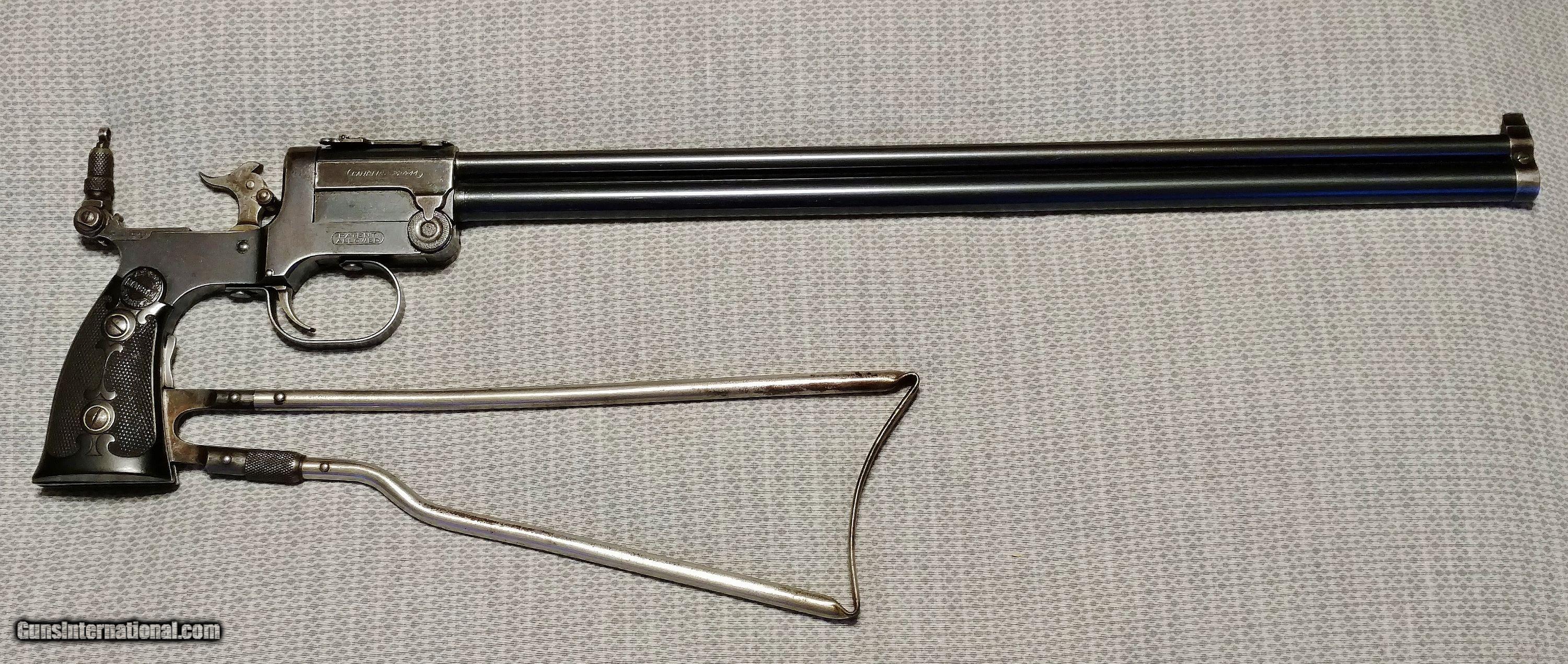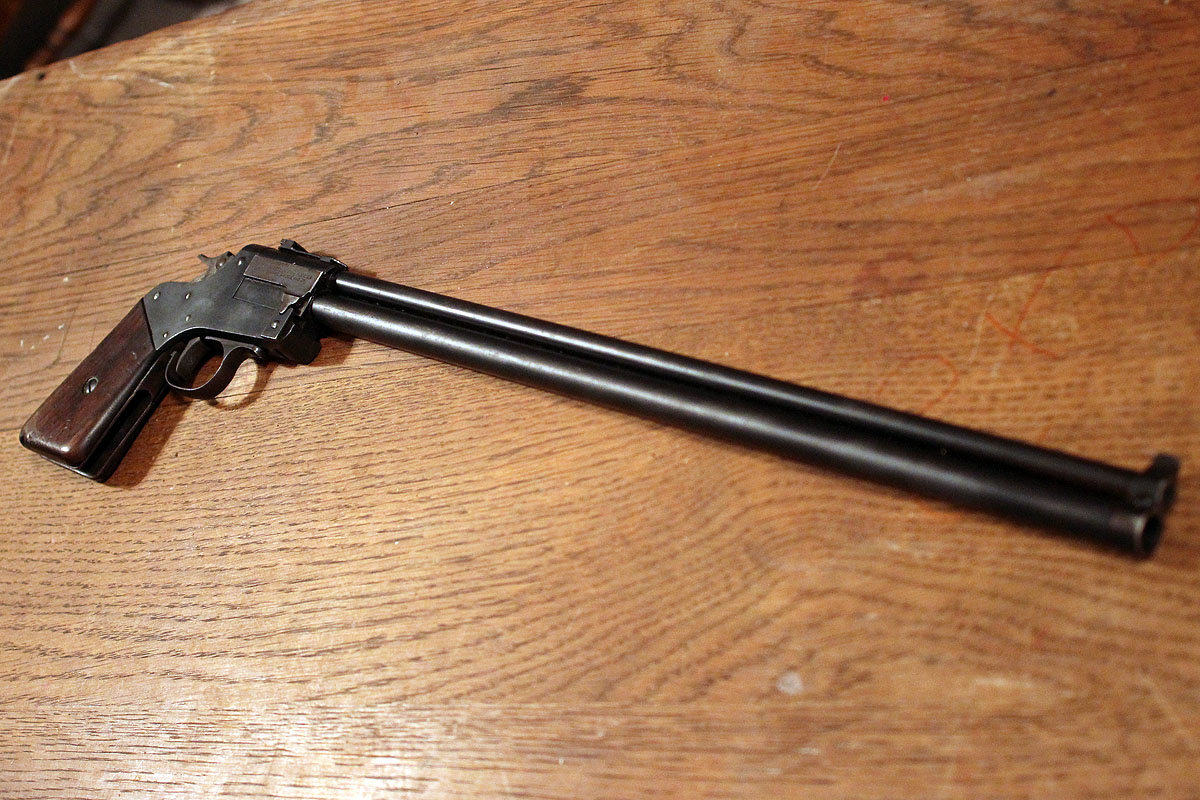Marble's tang sights were made to fit a wide variety of guns. Far left is for the Game GetterType your paragraph here. From the Factory: Sixty No. 8 shot in a 12 inch target, 6 round balls in a 2 inch bullseye, and 10.22 bullets in a 1 ½ inch circle—all at 50 feet with a 12 inch barrel and the same sight setting. Marble's Game Getter Gun—NFA, curio or relic Marble's suspended sales of Game Getter in United States after Treasury Department ruled it was a 'firearm' under NFA, but continued sales abroad. Retail price in 1934 was about $24 (12' or 15' barrels) to $26 (18' barrels).
This firearm is defined as a handgun, if purchased by a North Carolina resident a valid North Carolina concealed carry permit is required (or) a permit from the Sheriff of the County from which the purchaser resides
These guns are defined as firearms by Federal Law and cannot be released directly to any out of state buyers

Third Generation Marble Game Getter Gun
This firearm must be shipped to a FFL
Copy of valid state issued form of identification
Signature required
Curio & Relic:
This item is concidered a Curio & Relic, the buyer must have a valid curio and relic firearm license to take possession on site regardless of the state they reside.
Regulation implementing federal firearms laws, 27 CFR §478.11, defines Curio or Relic (C&R) firearms as those which are of special interest to collectors by reason of some quality other than is associated with firearms intended for sporting use or as offensive or defensive weapons.

To be recognized as C&R items, 478.11 specifies that firearms must fall within one of the following categories:
1. Firearms which were manufactured at least 50 years prior to the current date, but not including replicas of such firearms;


2. Firearms which are certified by the curator of a municipal, state, or federal museum which exhibits firearms to be curios or relics of museum interest; and
3. Any other firearms which derive a substantial part of their monetary value from the fact that they are novel, rare, bizarre, or because of their association with some historical figure, period, or event.
Marbles Game Getter On Gunbroker
The Marble's Game Getter
Marshall Williams
The Marble's Game Getter is one of those delightful little gun oddities which, like Ithaca's neat little 'Auto-Burglar Gun,' was legislated out of existence by the National Firearms Act of 1934 which, among other things, imposed burdensome restrictions on shotguns with barrels less than 18 inches long. If properly registered with the Bureau of Alochol, Tobacco and Forearms (BATF), the Marbles Game Getter is a valuable antique; if not registered, it is contraband. Regrettably, most Game Getters that I have seen were confiscated guns in police collections. (I do not have a copy of the BATF's list of curios and relics, it is possible that the Game Getter has been reclassified as a curio and relic which can save it.) A fair bit of history can be found in Fjested's Blue Book of Gun Values, and Krause Publications' Standard Catalog of Firearms, and I refer you those publications. However, I can sketch it out for you. There are two basic versions of the gun, the 1908 model and the 1921 model, both apparently designed by Webster L. Marble and Manufactured by the Marble Safety Axe Company, which became Marble's Arms & Mfg. Co, in 1911. The company still exists as CRR Inc./Marble's Inc. in Gladstone, Michigan, USA, and produces rifle sights and other gun specialties including the Poly-Choke device for shotguns. The gun pictured is the later 1921 model. While functionally similar, the 1908 gun has a distinctly different appearance, rather 'Victorian,' like a Webley revolver. I think it is more elegant, but also looks distinctly more fragile. The first 1908 gun was shipped from the factory in June of 1909. It was produced until 1914, but guns were shipped from factory stock until May 22, 1918. After that date, WWI would have interfered with any further production. Originally, the upper barrel was chambered for .22 short, long, and long rifle cartridges and the lower barrel chambered for the .44 shot and ball cartridges, but later guns could be had with the lower barrel chambered for the two inch .410. Standard barrel lengths were 12, 15, and 18 inches, but the factory offered any reasonable length on special order and barrels as short as 8 inches and as long as 22 inches are known. Some guns have no provision for the folding butt stock. It appears that the guns were shipped in a dovetailed wooden box with the holster, folding stock, a cleaning rod and instructions. The box is a valuable collectors item by itself. In 2000, a boxed set sold at auction for $3162.50 US. The .44 shot and ball cartridge had dimensions similar to or the same as the .44-40 Winchester, and the cartridges could be obtained either loaded with a small quantity of #8 chilled shot or a single round ball of about .425 inch diameter which should weigh about 115 grains. I can find no ballistic information on this load, but I surmise it would have had a velocity of over 1100 feet per second and a muzzle energy of about 310 foot pounds. The reason for the round ball load is that the Game Getter's lower barrel is unrifled and a longer pointed bullet would not have shot as accurately. The shot cartridges may be found either with an extra long case crimped over the shot charge or with bullet-shaped paper or wooden capsule filled with shot. Again, I have no reference before me, but I think the crimped case held 5/16 ounce of #8 shot and the capsule contained 3/8 ounce. Thus, a hunter armed with the Marble's Game Getter was prepared for small game with the .22, birds with the shot cartridge, and larger game with the ball cartridge. The 1921 gun originally had the upper barrel chambered for the .22 short, long and long rifle and the lower barrel chambered for the two inch .410 shell, but, starting in 1924, the lower barrel could be chambered for the 2 ½ inch shell. Apparently both chamberings were available for a period, but eventually the 2 ½ inch chambering won out. None are thought to have three inch chambers. The 1921 also was shipped with folding stock, holster and instructions but in a cardboard box. Values of the 1921 are only very slightly lower than values for the 1908. Both models were advertised with some other calibers of barrels including .25-20, 32-20, and .38-40. Such guns, if any were made, are extremely rare. I have a reprint of the 1940 Stoeger's Shooter's Bible which shows the Game getter with accessories priced at $24 US. For comparison, the Stevens .22-.410 over and under with 'Tenite' (plastic) stock sold for $15.10. I was very much surprised to learn that production of the Game Getter continued into the early 1950s. I had always been told that it was killed by the NFA and did not survive WWII. However, Marble's Game Getters with 18 inch barrels would not have been covered by the NFA and apparently many Game Getters were exported to places where such restrictions did not apply. In round figures, about 10,000 of each model were produced. My totally unscientific guess, based on the precious few Marble's Game Getters that I have seen, is that the 12 inch barrel guns were most popular. That is the only barrel length I have seen. The old Marble's Game Getter was and is a very neat and useful gun for a 'woods loafer' or hunter/camper. Easily portable and nearly as useful as a Swiss Army knife, it is a shame it is essentially unavailable. For ALOOF, Marshall Williams See also http://www.atf.gov/content/firearms/firearms-technology/curios-relics and www.atf.gov |